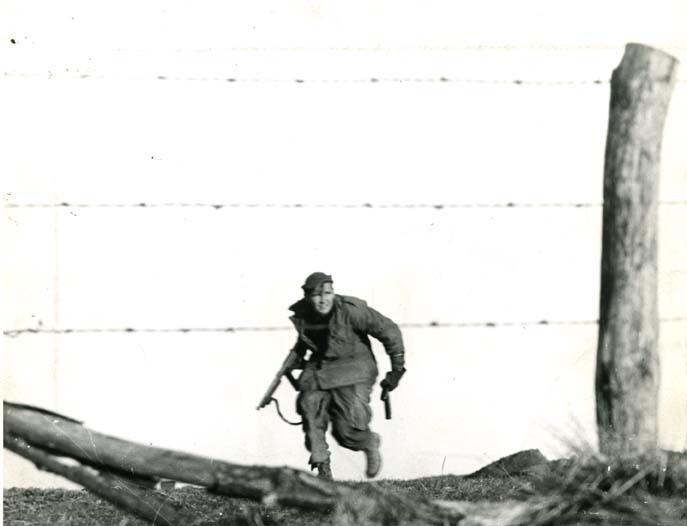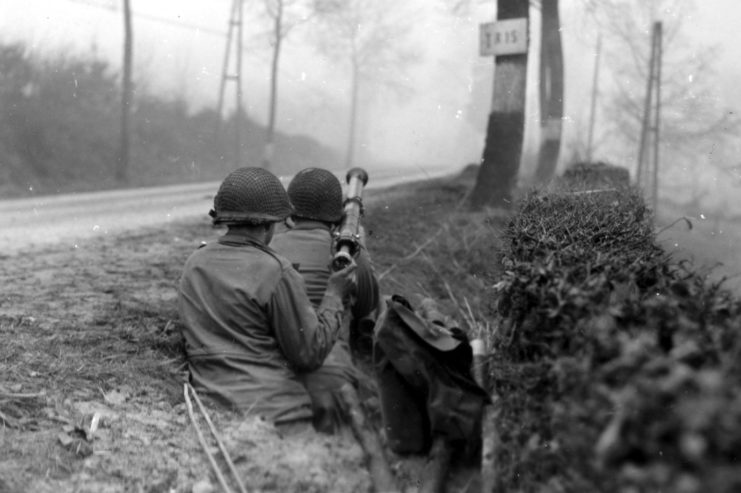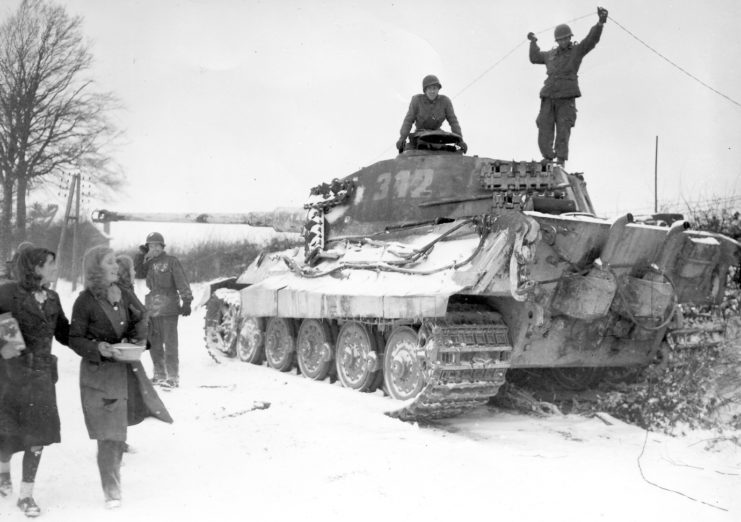The 504th Parachute Infantry Regiment was alerted at 2200 hours on 17 December 1944 following the return of Colonel Reuben Tucker., Regiment’s Commander, from the Division Headquarters where he had been summoned in regard to the enemy breakthrough into Belgium and Luxembourg.
Immediate preparations were made and by down 18 December the regiment was ready to move out. At 1700 hours 18 December, the first serial of the regimental convoy left Camp Sissone, followed at 5 minute intervals by the second and third serials.

Along the way, the original destination, Bastogne, was changed to Werbomont, Belgium, which was more seriously threatened. The convoy arrived at Werbomont early in the morning of 19 December, and the regiment took up positions in a defensive perimeter on the high ground around Werbomont – an important junction (Highways 15 and 23) on the Bastogne – Liege lateral road of communications.
Shortly thereafter, the regiment moved on foot eight miles to set up a defensive position before the village of Rahier. The 1st Battalion remained inside the town in reserve for an attack the next day on Cheneux – two miles North.
The 1st Battalion, 504th Regiment moves through Rahier toward Cheneux, Belgium.
At 1400 hours, 20 December, the 1st Battalion, less Company “A”, which went to Brume, moved toward Cheneux and engaged an estimated battalion of the 1st Panzer Grenadier Regiment of the 1st SS Division.

The enemy column, stalled in Cheneux, apparently had more armor then originally estimated. 20mm flak guns on half-tracks firing from the town slowed the battalion’s advance. Two tank destroyers (M-36), supposed to assist the attack, were not effective.
By the middle of the morning 21 December, Cheneux was in the regiment’s hands when the 3rd Battalion made a wide flanking maneuver to enter the village from the North through Monceau. Enemy vehicles put out of service included 14 flak wagons, six half-tracks, four trucks, four 105mm field artillery pieces and one MK VI tank. Companies “B” and “C” suffered 225 casualties, 23 of whom were killed in action.
During the period 21-24 December, the regiment’s troops were reshuffled with the 2nd Battalion moving South of Lierneux to aid the 325th Glider Infantry and the 1st Battalion to the 505th Parachute Infantry Regiment at Trois-Ponts.
The regiment was alerted on the night of 22 December against an enemy parachute drop. The drop materialized, but equipment bundles containing gasoline, rations and ammunition were dropped, instead of troops.

The 3rd Battalion, less Company “C”, went into position Southwest of Vielsalm, 24 December, to act as a screening force for the 325th Glider. The battalion that night with stood an infantry attack.
The 1st Battalion went into breakthrough positions at Bra, 25 December, when it was put into regimental reserve. The 2nd and 3rd Battalions withdrew successfully to Bra to establish a 5 miles defensive line from Vaux-Chavanne to Floret.
Click on the image below to listen to Bruce’s podcast – he has some first hand history with the epic story.
Four counterattacks were repulsed during the ensuing week, the regiment meeting troops ranging from company to battalion strength. Roadblocks were established, concertina wire and mines were laid, and patrols were sent out.
The 1st Battalion left its reserve position at Bra 2 January 1945 to relieve the 325th Glider on the regiment’s right flank.I ntense enemy artillery fire set a number of fires within Bra.
Relieved of the Bra sector 4 January by the 329th Infantry Regiment (83rd Division), the 504th marched 15 miles to the vicinity of Fosse. The 2nd and 3rd Battalions attacked, and gained the high ground southeast of Fosse, overlooking the Salm River. Enemy resistance was light, consisting largely of small isolated units. Enemy counterattacks in company strength were broken up by the 3rd Battalion.
On 9 January 1945, the entire regiment, with the 551st Parachute Battalion, attacked to gain the West bank of the Salm River. Resistance, strong in the early stages of the attack, grew light with the 2nd Battalion meeting some strong opposition in the final phases of the advance.
By nightfall the regiment had established a line six miles along the West bank of the river from Rochelinval (551) to the Northern edge of Vielsalm. The line was held until 11 January 1945, when the regiment was the 291th Infantry Regiment, 75th Infantry Division.
During the 24 days, the 504th Regiment suffered 433 casualties: 58 killed, 354 wounded and 21 missing.
Source:Combat Interview from NARA: National Archives = 1945
You can follow Bruce and his amazing stories here and on the social media below:

